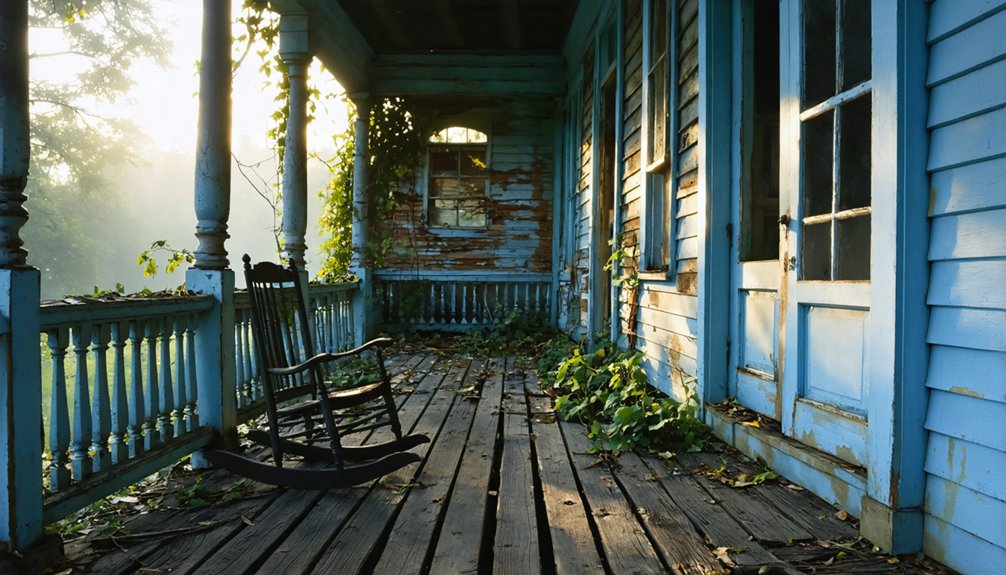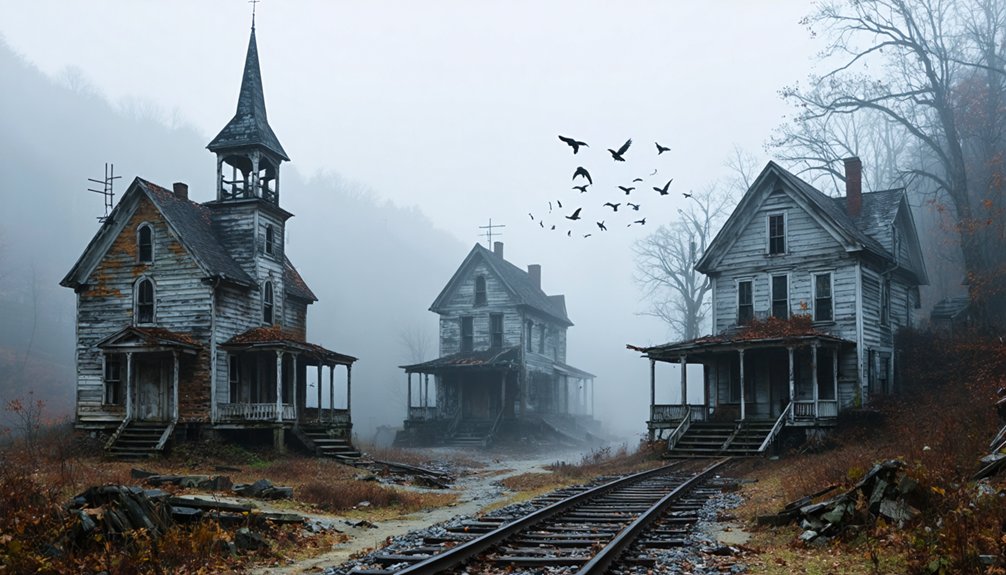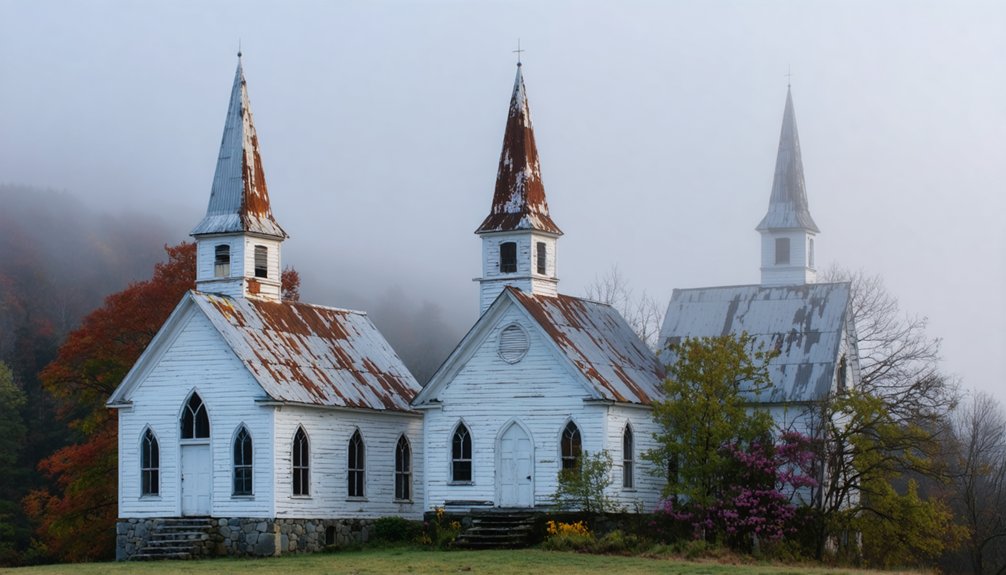You’ll discover haunting beauty throughout Appalachia’s abandoned settlements, from Thurmond’s frozen-in-time rail hub to submerged communities beneath Fontana Lake. Explore crumbling mining operations along New River Gorge, where miners once earned $2 daily extracting coal. Visit during late spring to early fall for ideal conditions, and bring a wide-angle lens to capture weathered doorways and rusted machinery. These silent towns whisper stories of displacement, industry, and resilience waiting to be heard.
Key Takeaways
- Appalachia’s ghost towns offer glimpses into vanished communities, from underwater settlements like Proctor to preserved railroad hubs like Thurmond.
- Guided hikes and annual gatherings at historical sites provide authentic experiences through local storytelling and heritage connections.
- Late spring through early fall offers ideal exploration conditions, with summer providing extended daylight for deeper site visits.
- Preserved mining operations at Kaymoor and Nuttallburg showcase intact industrial sites where miners once earned $2 per day.
- Photography enthusiasts can capture haunting imagery using wide-angle lenses, tripods, and thoughtful framing through weathered doorways.
The Submerged Communities of Fontana and Norris Lakes
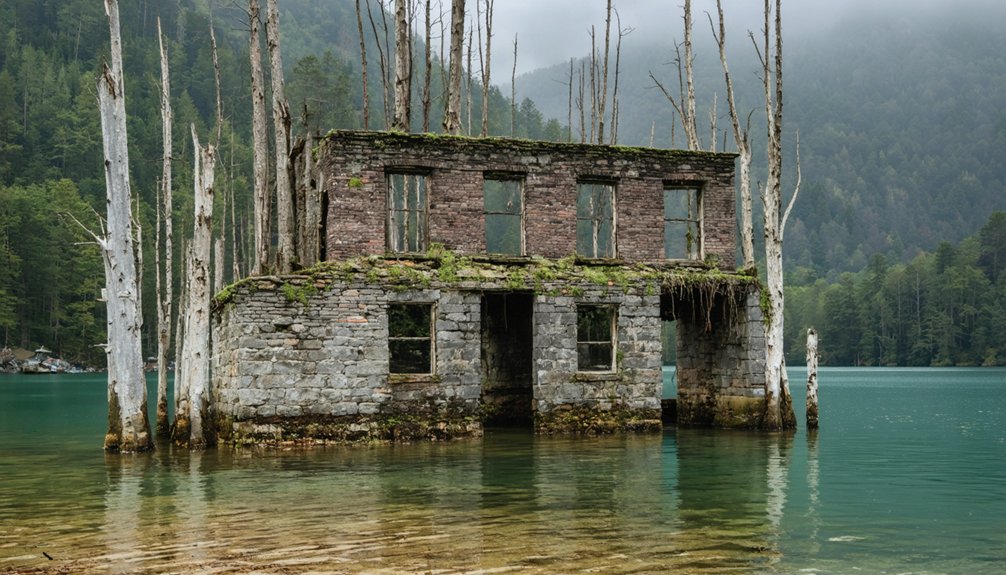
The hidden world beneath Fontana and Norris lakes holds the ghosts of Appalachian communities, submerged decades ago in the name of progress. When you visit during low water periods, you’ll glimpse foundations of Judson, Bushnell, and Proctor—once-thriving towns sacrificed for hydroelectric power during World War II.
Over 1,300 families were displaced as their cultural heritage vanished underwater. Churches, schools, and cemeteries containing ancestral remains were abandoned, creating a profound disconnect for descendants.
In Proctor alone, 1,200 families scattered, leaving behind generations of submerged memories. The town once had a vibrant community life with its own rolling post office, schools, churches, and even a theatre.
Today, you can explore remnants like the Calhoun House near Proctor’s shore, bearing witness to the communities that surrendered their existence for regional development and national interests. Many residents received inadequate compensation for their land, deepening the injustice of their forced relocation.
Thurmond: A Frozen-in-Time Rail Hub of West Virginia
While forgotten communities rest beneath Appalachian waters, others stand frozen in time above ground. You’ll find Thurmond, West Virginia, clinging to its mountainside perch—a perfectly preserved chapter of America’s railroad glory days.
Once handling more coal than Cincinnati with 18 rail lines converging at its station, this boomtown thrived in the 1920s before falling silent. By 1910, the town generated $4.8 million in freight revenue for the C&O Railroad.
The thunder of industry echoed through Thurmond’s valley as black gold flowed through its veins before time swept it all away.
As you wander its empty streets, you’ll feel the dual character of this peculiar place—Captain Thurmond’s strictly dry, Baptist-ruled town on one side, and across the river, the notorious playground of gambling, drinking, and jazz.
The Dun Glen Hotel’s ruins still echo with ghostly tales of high-stakes poker games and violent confrontations.
Today, haunting folklore surrounds the abandoned buildings, making Thurmond a living museum of Appalachian boom-and-bust destiny. The town experienced a devastating fire in 1899 that forced residents to rebuild much of what visitors see today.
Abandoned Mining Operations Along New River Gorge
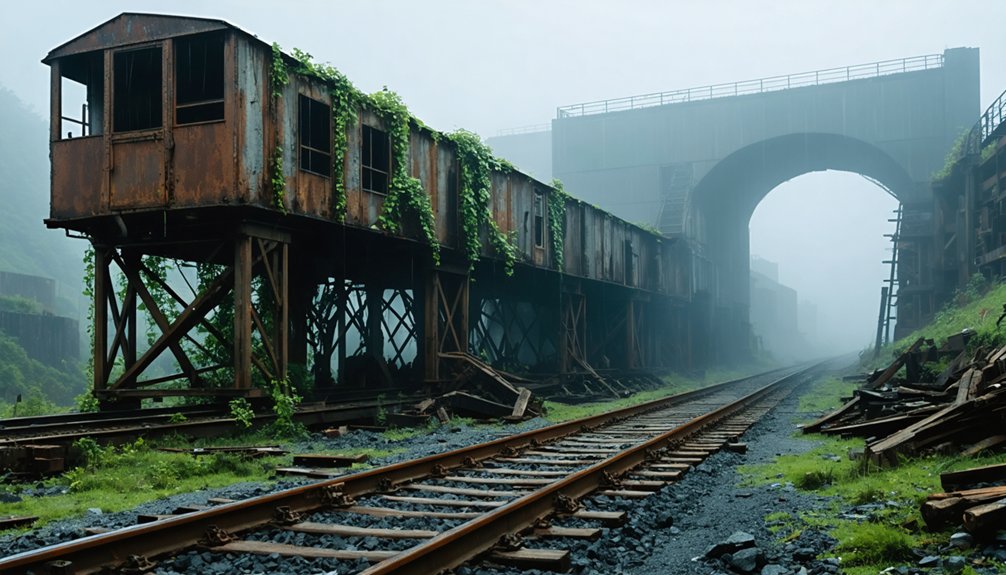
Hidden beneath encroaching Appalachian forests, over sixty once-bustling mining communities lie scattered throughout New River Gorge, their crumbling foundations whispering stories of industrial ambition.
You’ll find the ghostly remnants of Kaymoor and Nuttallburg—two of the most intact sites—where miners once earned just $2 per day extracting coal. The landscape’s unique geography, shaped by the river flowing northward, preserved these historical sites despite the region’s dramatic geological changes. As you explore towering conveyor belts, abandoned coke ovens, and sealed mine portals, you’re walking through America’s industrial past.
These sites flourished after the Chesapeake & Ohio Railroad’s 1873 completion doubled local coal production. The Thurmond depot once accommodated up to 95,000 passengers annually during the region’s peak industrial activity. By the 1960s, most towns emptied as operations shuttered, leaving a complicated mining legacy.
Today, forest reclaims the rusting infrastructure while environmental wounds persist—acid drainage affects watersheds, and mountaintop removal altered over 1.5 million acres of landscape.
Still, these preserved ruins offer freedom to connect with Appalachia’s resilient spirit.
Capturing the Essence: Photography Tips for Ghost Town Explorers
Capturing the perfect ghost town photograph requires preparation beyond simply bringing a camera to these haunted Appalachian sites. Pack a wide-angle lens for sweeping vistas and cramped interiors, while a sturdy tripod will prove essential for low-light situations and night photography.
Frame your shots through weathered doorways to create depth, or shoot wide to establish the town’s scale. You’ll find ghostly textures in peeling paint and rusted machinery—these silent stories deserve close-up attention with prime lenses. For dramatic effect, try black-and-white processing to emphasize mood and weathering.
When shooting at night, capture star trails above abandoned structures or experiment with light painting. The golden hour provides magical lighting conditions that beautifully illuminate historical structures against dramatic landscapes.
Thoroughly research locations beforehand to ensure you won’t encounter private property restrictions or areas requiring special permits or fees.
Always remember to photograph respectfully—never move artifacts or trespass, as preservation of these fragile time capsules depends on responsible visitors.
What Lies Beneath: The Stories of Underwater Settlements

Beneath Appalachia’s tranquil lake waters lie entire communities frozen in time—towns that once bustled with life now rest silently underwater.
The echoes of forgotten towns linger beneath these placid waters, their stories suspended in liquid amber.
When you gaze across Fontana Lake or Summersville Lake, you’re looking at underwater history created through infrastructure projects that sacrificed communities for progress.
The town of Proctor vanished beneath Fontana Lake in 1943, while Gad’s remains emerge every decade when Summersville Lake drains for maintenance.
Loyston’s submersion under Norris Lake was even documented by photographer Lewis Hine before its 1935 flooding.
These submerged heritage sites tell poignant stories of displacement—elderly residents of Gad never recovered from losing generational farmland, while Proctor residents waited for promised roads that never materialized.
Proctor’s cemetery stands as a haunting reminder of the town’s past, with former residents gathering annually on Decoration Day to honor their ancestors and maintain their connection to home.
Today, divers occasionally glimpse these time capsules—standing forests and the resilient Attakulla Lodge still intact beneath the surface, while adventurous visitors can explore Gad’s underwater ghost town through scuba diving tours offered by local businesses.
Seasonal Travel Guide to Accessible Appalachian Ruins
Visitors seeking to explore Appalachia’s abandoned settlements must carefully plan their journeys, as accessibility varies dramatically across these atmospheric ruins.
Late spring through early fall offers ideal conditions, with summer providing extended daylight for deeper exploration of sites like Elkmont’s preserved structures and Lost Cove’s remote foundations.
Your approach depends entirely on location—Blue Heron welcomes you by train, while No Business demands rugged hiking with proper footwear.
Hiking safety becomes essential when traversing unstable terrain, especially during rainy periods when trails to remote sites become treacherous.
Fall delivers a spectacular backdrop of changing foliage, while winter visits require additional preparation for seasonal weather challenges.
Remember that some locations enforce regulations or require permits, particularly those within national parks or protected lands.
Preservation Efforts and Heritage Tourism Opportunities

You’ll find passionate locals fighting to preserve their mountain heritage through initiatives like the “Saving Mountain Memories” project, where deteriorating company stores and miners’ homes receive new life through careful restoration.
When you follow the “Trail To Yesterday,” interpretive markers guide you through abandoned sites where coal once fueled America’s industrial revolution, connecting you to stories that might otherwise vanish into the hillsides.
These preservation efforts not only protect physical remnants but create tourism opportunities that bring much-needed economic hope to communities still recovering from industrial decline.
Saving Mountain Memories
Across the rugged landscapes of Appalachia, preservation efforts battle against time and the elements to rescue the fading memories of once-thriving communities.
You’ll find local historians capturing community storytelling through oral histories and digital archives, preserving voices that might otherwise be lost to time.
Despite harsh weather conditions and limited funding—with 73% of abandoned mine lands still unreclaimed—you can witness remarkable transformations.
In Dante, Virginia, former mining land now offers 16 miles of trails where you can hike through historical significance.
Visit Thurmond, West Virginia to walk streets that stand as evidence of Appalachian resilience.
These preservation projects aren’t just about protecting buildings; they’re safeguarding proof that these abandoned places mattered—physical evidence of the labor and love that built America’s foundation.
Trail To Yesterday
How do forgotten mountain communities find new life in the digital age? Through passionate conservation efforts like the Southern Appalachian Highlands Conservancy‘s acquisition of Lost Cove—a 95-acre ghost town nestled in Pisgah National Forest.
You’ll soon have opportunities to walk where self-sufficient mountaineers once thrived, as guided hikes launch to balance preservation with exploration.
As you venture through Appalachia’s abandoned settlements, you’re participating in a carefully orchestrated revival. The National Park Service and preservation groups have transformed places like Thurmond and Elkmont from crumbling ruins into immersive historical experiences.
Digital documentation, oral histories, and accessible trails now connect you directly to mountain heritage despite challenges of remote locations and harsh climates.
These ghost towns aren’t just relics—they’re bridges between yesterday’s isolation and today’s connected world.
Voices From the Past: Connecting With Former Residents’ Memories
You’ll discover rich tapestries of life woven through oral histories collected from former residents who witnessed Appalachian ghost towns in their prime.
These precious narratives come alive during community remembrance gatherings, where elderly locals share stories of moonshine operations, mining accidents, and supernatural encounters tied to specific landmarks.
Through these firsthand accounts, you’re granted intimate access to vanished worlds that official records simply can’t capture.
Oral Histories Preserved
When aging residents of Appalachia’s ghost towns speak, they’re not just sharing stories—they’re breathing life into vanished communities. Their oral traditions paint vivid pictures of Saturday night dances, church picnics, and daily life before the industries departed.
Through university programs and dedicated archivists, these historical narratives are now digitally preserved for generations to come.
- Listen to authentic accounts of folk remedies and mountain superstitions
- Explore African American mountain communities through recently digitized interviews
- Follow walking tours designed by locals who remember these places firsthand
- Access thousands of recordings through SPOKEdb and Southern Appalachian Digital Collections
- Discover stories that remained hidden for decades before preservation efforts
You’ll find these voices—once in danger of being silenced forever—now immortalized, waiting for you to discover the authentic human experience behind abandoned storefronts and crumbling foundations.
Community Remembrance Gatherings
Every summer, as mountain laurel blooms across abandoned hillsides, the ghosts of Appalachia’s forgotten towns briefly reawaken.
You’ll witness descendants placing folding chairs among crumbling foundations, creating a poignant tableau of presence amid absence. These annual gatherings transform overgrown sites into vibrant hubs of memory storytelling, where weathered hands pass mining scrip and faded photographs between generations.
Join local historians for heritage hikes through ruins, where communal rituals unfold naturally—candles lit at family plots, names spoken aloud under ancient oaks, shared meals that echo bygone community celebrations.
You’ll find yourself drawn into the circle as elders recount legends and lost ways of life. These gatherings aren’t just about honoring the past—they’re about keeping its spirit alive in the mountain air.
Frequently Asked Questions
Are There Paranormal Investigation Opportunities in Appalachian Ghost Towns?
You’ll encounter otherworldly experiences through paranormal tours at Bell Witch Cave, ghost hunting at Nickerson Snead House, and exploring the West Virginia Paranormal Trail, where residual spirits await your investigation.
What Safety Precautions Should Explorers Take When Visiting Abandoned Structures?
Always assess structural integrity before entering. Bring a buddy, flashlight, and first aid kit. You’ll need sturdy boots, gloves, and a helmet during exploration. Safety trumps adventure when floors creak ominously.
How Do Local Communities Feel About Tourism to These Abandoned Areas?
You’ll find community sentiments mixed—locals value tourism’s $1.7 million economic impacts while balancing preservation concerns. They’re actively documenting stories, creating heritage sites, and developing sustainable tourism that honors their cultural fabric.
Can Artifacts Be Legally Collected From Appalachian Ghost Towns?
Like walking a legal tightrope, you can’t freely collect artifacts from ghost towns. You’ll need explicit landowner permission, as artifact preservation is protected by strict legal regulations across Appalachia.
What Wildlife Hazards Might Be Encountered in These Remote Locations?
You’ll face venomous snakes, rabid mammals, disease-carrying rodents, and aggressive stinging insects. Stay vigilant during wildlife encounters and maintain predator awareness while exploring these deteriorating, overgrown historical sites.
References
- https://www.thewanderingappalachian.com/post/the-underwater-towns-of-appalachia
- https://en.wikipedia.org/wiki/Lists_of_ghost_towns_in_the_United_States
- https://www.geotab.com/ghost-towns/
- https://appalachianmemories.org/2025/10/16/the-lost-towns-of-appalachia-the-forgotten-mountain-communities/
- https://www.youtube.com/watch?v=4oHlJFXbrCk
- https://www.appalachianhistory.net/category/ghost-towns-2
- https://wlos.com/news/local/north-carolina-fontana-lake-proctor-town-submerged-underwater-history-100-years-ancestors-families-shorelines-world-war-2-lee-woods-historian
- https://www.thesmokymountaintimes.com/local-news/under-water-stories-towns-lost-fontana-lake
- https://www.explorebrysoncity.com/the-history-of-the-road-to-nowhere-in-swain-county/
- https://avltoday.6amcity.com/remembering-judson-wncs-underwater-ghost-town
